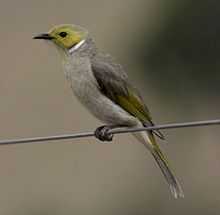White-plumed Honeyeater
From Wikipedia, the free encyclopedia
| White-plumed Honeyeater | |
|---|---|
 | |
| At Sundown National Park, Queensland, Australia | |
| Conservation status | |
| Scientific classification | |
| Kingdom: | Animalia |
| Phylum: | Chordata |
| Class: | Aves |
| Order: | Passeriformes |
| Family: | Meliphagidae |
| Genus: | Lichenostomus |
| Species: | L. penicillatus |
| Binomial name | |
| Lichenostomus penicillatus (Gould, 1837) | |
The White-plumed Honeyeater (Lichenostomus penicillatus) is a bird native to Australia. It is yellow above and paler beneath, with a black and white line on the sides of its neck. The white neck band of a White-plumed Honeyeater is its most prominent feature, the rest of the feathers being shades of green and buff. Juveniles have a pinkish orange beak that darkens to black in adults. Honeyeaters feed on nectar and insects and their nest is a small cup nest in a tree. The size of an average White-plumed Honeyeater is approximately 19 cm.
-
The cup nest
-
Nest with two eggs
References
- ↑ BirdLife International (2012). "Lichenostomus penicillatus". IUCN Red List of Threatened Species. Version 2013.2. International Union for Conservation of Nature. Retrieved 26 November 2013.
| Wikimedia Commons has media related to Lichenostomus penicillatus. |
This article is issued from Wikipedia. The text is available under the Creative Commons Attribution/Share Alike; additional terms may apply for the media files.


